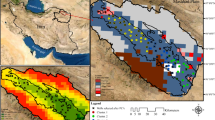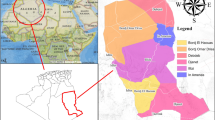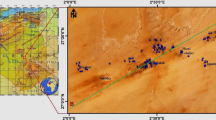Abstract
Disasters caused by water inrush during production affect many coal mines in China. To rapidly and accurately prevent further water inrush, a comprehensive identification model combining hydrochemistry analysis, water source detection, and water channel exploration is proposed. The Schukalev classification method (SCM) is used to distinguish the concentration distribution of the main ion between the water inrush source and other aquifers, and hierarchical cluster analysis (HCA) is adopted to classify the water samples in the hydrochemistry analysis stage. Water channel exploration and water source detection are combined to test and verify the conclusion in the third stage. The comprehensive discrimination model is applied to the water inrush of the Buliangou coal mine. Hydrochemistry analysis shows that the percentages of the main ions (Na+, Ca2+, Mg2+, HCO3−, and Cl−) are greater than 30% (excluding SO42−), which is in agreement with the case of a sandstone aquifer. In the second stage, water source detection based on the transient electromagnetic method (TEM) and drilling technique indicates that not much water is present in the anomaly area around the water inrush location. The limited water recharge contradicts the phenomenon of water inrush. Water channel exploration is carried out, and an area with massive fissures that have water storage capacity is revealed. The conclusion is that the water conserved in the fissures flows out over a short time without the occurrence of stable recharge. The comprehensive discrimination model has complementary advantages and improves the water inrush prediction efficiency.








Similar content being viewed by others
References
Anderberg MR (1973) Cluster analysis for applications. Probability & mathematical statistics New York Academic Press
Areerachakul S and Sanguansintukul S (2010) Clustering analysis of water quality for canals in Bangkok, Thailand. Computational Science and ITS Applications—ICCSA 2010, International Conference, Fukuoka, Japan, March 23–26, 2010, Proceedings. DBLP, 2010: 215–227
Bathrellos GD, Skilodimou HD, Kelepertsis A, Alexakis D, Chrisanthaki I, Archonti D (2008) Environmental research of groundwater in the urban and suburban areas of Attica region, Greece. Environ Geol 56(1):11–18
Bo Y, Liu C, Zhao Y, Wang L (2015) Chemical and isotopic characteristics and origin of spring waters in the Lanping–Simao basin, Yunnan, southwestern China. Chemie der Erde—Geochemistry—Interdisciplinary Journal for Chemical Problems of the Geosciences and Genecology 75(3):287–300
Chang JH, Yu JC, Liu ZX (2016) Three-dimensional numerical modeling of full-space transient electromagnetic responses of water in goaf. Appl Geophys 13(3):539–552
Cheng J, Li F, Peng S (2015) Joint inversion of TEM and DC in roadway advanced detection based on particle swarm optimization. J Appl Geophys 123:30–35
Dou H, Ma Z, Cao H, Feng L, Hu W, Li T (2011) Application of isotopic and hydro-geochemical methods in identifying sources of mine inrushing water. Int J Min Sci Technol 21(3):319–323
Güler C, Thyne GD, McCray JE, Turner KA (2002) Evaluation of graphical and multivariate statistical methods for classification of water chemistry data. Hydrogeol J 10(4):455–474
Helstrup T, Jorgensenet NO, Banoeng-Yakubal B (2007) Investigation of hydrochemical characteristics of groundwater from the Cretaceous-Eocene limestone aquifer in southern Ghana and southern Togo using hierarchical cluster analysis. Hydrogeol J 15(5):977–989
HU W, Dong S, Yan L (2011) Water hazard control technology for safe extraction of coal resources influenced by faulted zone. Procedia Earth Planet Sci 3:1–10
Huang J, Sun S, Xue Y, Zhang J (2015) Changing characteristics of precipitation during 1960–2012 in Inner Mongolia, northern China. Meteorol Atmos Phys 127(3):257–271
Jiang XY, Yu ZG, Ning JS, Chen HT, Mi TZ (2006) Genesis of underground brine along south coast of Laizhou Bay: hydrochemical characteristics. Chin J Oceanol Limnol 24(4):435–442
LI G, Wang X, Meng Z, Zhao H (2014) Seawater inrush assessment based on hydrochemical analysis enhanced by hierarchy clustering in an undersea goldmine pit, China. Environ Earth Sci 71(12):4977–4987
Li G, Zhou W (2006) Impact of karst water on coal mining in North China. Environ Geol 49(3):449–457
Liu H, Cao Y (2011) Technologies of preventing coal mine water hazards for sustainable development in North China. Geotech Geol Eng 29(1):1–5
Ma F, Zhao H, Guo J (2015) Investigating the characteristics of mine water in a subsea mine using groundwater geochemistry and stable isotopes. Environ Earth Sci 74(9):1–13
Panagopoulos G, Angelopoulou D, Tzirtzilakis E (2016) The contribution of cluster and discriminant analysis to the classification of complex aquifer systems. Environ Monit Assess 181(10):591
Peng K, Li X, Wang Z (2015) Hydrochemical characteristics of groundwater movement and evolution in the Xinli deposit of the Sanshandao gold mine using FCM and PCA methods. Environ Earth Sci 73(12):1–16
Papadopoulou-Vrynioti K, Alexakis D, Bathrellos GD, Skilodimou HD, Vryniotis D, Vasiliades E (2014) Environmental research and evaluation of agricultural soil of the Arta plain, western Hellas. J Geochem Explor 136:84–92
Qiu M, Shi L, Teng C, Zhou Y (2016) Assessment of water inrush risk using the fuzzy Delphi analytic hierarchy process and Grey relational analysis in the Liangzhuang Coal Mine, China. Mine Water Environ 1–12
Singaraja C, Chidambaram S, Prasanna M, Thivya C (2014) Statistical analysis of the hydrogeochemical evolution of groundwater in hard rock coastal aquifers of Thoothukudi district in Tamil Nadu, India. Environ Earth Sci 71(1):451–464
Sun L (2014) Statistical analysis of hydrochemistry of groundwater and its implications for water source identification: a case study. Arab J Geosci 7(9):3417–3425
Sun YJ, Xu ZM, Dong QH et al (2008) Forecasting water disaster for a coal mine under the Xiaolangdi reservoir. China Univ Mining Technol 18(4):516–520
Wang J, Li X, Cui T, Yang J (2011) Application of distance discriminant analysis method to headstream recognition of water-bursting source. Procedia Eng 24(6):374–381
Wang J, Zhong H, Feng L (2012) A model of coal mine water disaster emergency logistics risk assessment based on AHP and BP neural network. Future Communication, Computing, Control and Management:535–542
Wu Q, Wang M (2006) Characterization of water bursting and discharge into underground mines with multilayered groundwater flow systems in the North China coal basin. Hydrogeol J 14(6):882–893
Wu Q, Guo X, Shen J et al (2017) Risk assessment of water inrush from aquifers underlying the Gushuyuan coal mine, China. Mine Water & the Environment 36(1):1–8
Xiao L, Tang SH, Zhao CL, Yuan TX, Yang W (2013) Grey-risk estimation of the water inrush from no. 9 coal floor in Guoerzhuang mine. Appl Mech Mater 295-298:3019–3022
Xiao Y, Wu R, Zhang P et al (2016) Application of radio wave penetration field strength increment method in detection by coal face roadway. Min Saf Environ Prot 36-40(In Chinese)
Xu C, Gong P (2011) Water disaster types and water control measures of Hanxing coal mine area. Procedia Earth Planet Sci 3(3):343–348
Yang B, Wanghua S, Lihong D (2017) Risk assessment of water inrush in an underground coal mine based on GIS and fuzzy set theory. Mine Water Environ 36(4):617–627
Yang B, Junhong Y, Lihong D (2018) Development of a system to assess vulnerability of flooding from water in karst aquifers induced by mining. Environ Earth Sci 77(3):91–104
Yao M, Liu P, Shang M, Tao Y, Lei C, Cao L (2016) Determining sources of mine water based on hydraulic characteristics analysis of a fault system. Environ Earth Sci 75(10):858
Zhang J (2005) Investigations of water inrushes from aquifers under coal seams. Int J Rock Mech Min Sci 42(3):350–360
Zhang ZG, Zhang HR, Du PJ (2006) Application of SVM in analyzing the headstream of gushing water in coal mine. China Univ of Mining &Tech 16(4):433–438
Funding
The authors acknowledge the financial support from the National Basic Research Program of China (973) Funded Project (Grant No. 2013CB227900) and the National Key R&D Program of China (Grant No. 2017YFC0804101).
Author information
Authors and Affiliations
Corresponding author
Rights and permissions
About this article
Cite this article
Liu, Q., Sun, Y., Xu, Z. et al. Application of the comprehensive identification model in analyzing the source of water inrush. Arab J Geosci 11, 189 (2018). https://doi.org/10.1007/s12517-018-3550-2
Received:
Accepted:
Published:
DOI: https://doi.org/10.1007/s12517-018-3550-2




